| |
|
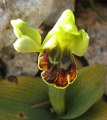 | |
| MaltaWildPlants.com by Stephen Mifsud |

|
| |
|
|
 |  |  |  |
| External Links: |
|
Hyoscyamus albus (White Henbane) |
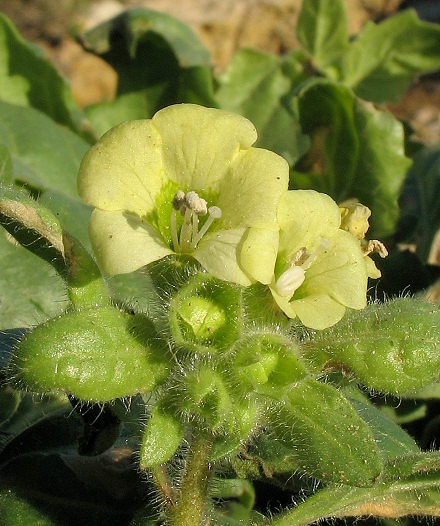
Hyoscyamus albus (SOLANACEAE.)
Images for this profile are taken from the Maltese Islands after year 2000. |
|
| Nomenclature |
Species name : | Hyoscyamus albus L. | Authority : | Carl von Linne, Sweden, (1707 - 1778) | Synonyms :
(basionym or principal syn.) |
|
Plant Family : | Solanaceae Juss.
(Potato Family) | English name(s) : | White Henbane, Russian Henbane | Maltese name(s) : | Mammażejża, Bang | Status for Malta : | Indigenous. Present on the Maltese islands before man | Name Derivation : |
Hyoscyamus: Hyos- meaning a pig, and -kyamos meaning a bean, alluding that it was fedto pigs, but the name is likely a derogatory reference, as some plants of this genus are poisonous to livestock and humans (e.g. Hyoscyamus nigra);. (Greek origin ); 2 = From the Greek "hyos" (= pig) and "kyamos" (=bean), but the name is likely a derogatory reference, as it is poisonous to livestock and humans (Greek);.
albus: Having a white colour. (Latin origin ); 2 = White (Latin).
| Remarks : | |
|
| Morphology and structure |
PLANT STRUCTURE: |
Character | Growth Form | Branching | Surface |
Description | | | |
General
Picture |  |  | 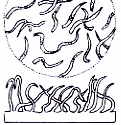 |
|
LEAVES: |
Character | Arrangement | Attachment | Venation |
Description | | | |
General
Picture |  | 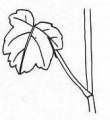 |  |
| |
Character | Leaf Shape | Leaf Margin | Remarks |
Description | | | Leaf Base Adult leaves have an indented base; young leaves don't. |
General
Picture |  |  |  |
|
FLOWERS: |
Character | Colour | Basic Flower Type | No. of Petals | No. of Sepals |
Description | Pale Yellow-Green Some specimens have a brown throat, other possess a white to pale green one.). | | 5 Two thirds of the petal length is fused leaving 5, apical distinct lobes. | 1 (Fused) Sepals are fused into a single calyx with 5 apical teeth. |
General
Picture | | 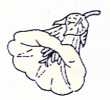 |  |  |
| |
Character | Inflorescence | Description | Ovary | Stamens |
Description | | A pale yellow flower with a green or sometimes a purple-brown throat. Corolla is composed of 5 partially fused petals, where the lower two are somehow smaller. 5 stamens and a longer style protrude from the flower throat. Corolla tube covered by a tubular actinomorphic gamosepalous calyx with 5 teeth at the rim. | | |
General
Picture |  |  | 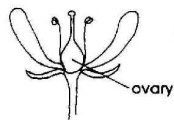 | 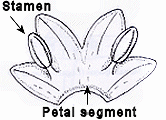 |
| |
Character | Scent | Average Flower Size | Pollen Colour | Other Notes |
Description | None | 20 mm x 32mm (Diameter x corolla length). | Pale yellow / Cream | - |
|
SEEDS: |
Character | No. Per Fruit | Shape | Size | Colour |
Description | 100-300 | Reniform Kidney-shaped seeds; rather swollen. | 2mm | Greyish Brown |
General
Picture |  |  |  |  |
|
FRUIT AND OTHER BOTANICAL DATA: |
Character | Fruit Type | Colour of Fruit | Subterranean Parts | Other Notes |
Description | | Brown Mostly hidden inside, at the base of the calyx toothed calyx. | | - |
General
Picture |  |  |  |  |
|
|
| Plant description and characters | |
Life Cycle: | Perennial (sometimes Annual). |
Growth Form: | THEROPHYTE (annual plants, herbaceous) |
Habitat: | Waste ground, streets, caves, stone piles, besides limestone walls, quarries, bastions, old farmhouses especially near the coast. |
Frequency: | Frequent |
Localities in Malta: | A large number of plants are found in the main public garden at Wied iz-Zurrieq. Seen scattered in few numbers throughout Malta and Gozo. Examples include Valletta (Evans Building), Santa Venera, Cittadella and Ghajn Abdul Quarry (Gozo). |
Plant Height: | 30-90cm. |
| Apr-May |
Protection in Malta: | Not legally protected till the last update of this website (2/Mar/2022) |
Red List 1989: | Not listed in the Red Data Book of the Maltese Islands |
Poison: | |
The White Henbane is a herbaceous plant living all year round as a perennial in Malta, although in some habitats it does not survive the arid Summer. It is a branching, erect plant (sometimes found ascending) with many fleshy soft leaves and pale yellow-green flowers. The stem is quite thick and robust, and mature plants can have their main stem with a woody base. Stems also have numerous white, villous, spread-out (patent) soft hairs about 2-3mm long. This gives the whole plant a soft texture. Less amount of hair is present on leaves, mostly found at their veins.
The alternately arranged leaves have a long petiole, more or less the same length of the lamina. The general leaf shape varies from triangular with a basal indentation in adult, to oval or sub-orbicular (nearly circular) without any basal indentation in younger ones. All leaves have a deeply serrated outline with blunt tipped teeth. Teeth of large adult leaves are sometimes seen to be developed into small lobes, each being self-serrated. The leaves measure between 4-9cm long to 3-8cm wide and have light green pinnate veins, more prominent from beneath.
The flowers are found as sessile spikes at the terminal part of the branches. The flower consists of a gamosepalous, green calyx and a gamopetalous corolla with 5 outer lobes, about 25mm in diameter. The calyx has a tubular-funnel shaped structure and measures 12-15mm in length. It is covered with soft, villous hairs. It also has 10 longitudinal pale green veins and 5 conspicuous teeth at its end, arranged actinomorphicly.
The perianth consists of a partially fused corolla with 5 lobes, the lower two being visibly smaller and hence making the flower rather zygomorphic. The colour is a pale yellow with slight hue of green. There are two colour forms, one with a pale green throat and another with a purple-maroon one. The latter also has stamens with purple filaments.
The male reproductive organs are 5 stamens of unequal lengths fused to the lower-middle part of the corolla (epipetalous). The anthers measure about 3-4mm in length and are covered with cream coloured pollen. The female part is a quite large rounded ovary with a style longer by few millimeters from the stamens. The style has a terminal swollen stigma. Flowers unscented, 1-3 in blossom per inflorescence.
After fertilization, the corolla falls off leaving the calyx and the developing fruit capsule at the base. This capsule is green, spherical/ovate in shape with a rounded polished capsule lid. When ripe, the capsule turns brown and the lid splits open with the result that the tiny seeds are liberated from the calyx opening by the swaying of the plant. The seeds are barely 2mm in length, have a swollen kidney shape and greyish-brown in colour.
|
|
| Information, uses and other details |
Nativity and distribution
20 species are found in Europe and from North Africa and the Sahara to south-western and central Asia. [WWW-27]
The distributional range of this plant is shown in the list below: [WWW-26]
Northern Africa: Algeria [n.] ; Egypt; Libya [probably] ; Morocco; Tunisia
Western Asia: Egypt - Sinai; Iraq; Israel; Jordan; Lebanon; Syria; Turkey; Saudi Arabia
Europe: Moldova; Ukraine {incl. Krym); Cyprus, Turkey, Albania; Bulgaria; Greece (incl. Crete); Italy (incl. Sardinia, Sicily); Romania; Yugoslavia; France (incl. Corsica); Portugal (incl. Azores, Madeira islands); Spain (incl. Baleares, Canary Islands).
Nomenclature
The herb is also called Hog's bean, and both its botanical name Hyoscyamus and the tenth-century Jusquiasmus are derived from the Greek words hyos and cyamos, signifying 'the bean of the hog,' which animal is supposed to eat it with impunity. An old AngloSaxon name for it was 'Belene,' probably from the bell-shaped flowers; then it became known as 'Hen-bell,' and from the time that its poisonous properties were recognized this name was changed to 'Henbane,' because the seeds were thought to be fatal to poultry. Dr. Prior is inclined to think that the name Henbane is derived from the Spanish hinna (a mule), e.g. 'henna bell,' referring to the similarity of its seed-vessel to the bell hung upon the neck of the mules. [WWW-03]
Similar properties of Hyoscyamus albus with H. niger (Official medicinal plant)
There are about eleven species of the genus Hyoscyamus, distributed from the Canary Islands over Europe and Northern Africa to Asia. All those which have been investigated contain similar principles and possess similar properties. [WWW-03]
In the South of Europe, RUSSIAN HENBANE (H. albus) - a native of the region of the Mediterranean, and so called from the pale colour of its flowers - is used as the official medicinal Henbane, and is regarded as equal in medicinal value to H. niger (BLACK HENBANE)
[WWW-03]
In France it is used indiscriminately with H. niger, though here it is not recognized as having identical properties. According to Pharmacographia, the Hyoscyamus of the Ancients was probably H. albus, and the white variety was preferred for internal use in the practice of more modern times. In France, too, White Henbane had the preference, though it was held to be milder in operation: only the seeds were official, whereas in the black variety only the leaves were official. [WWW-03]
Constituents of Henbane
The chief constituent of Henbane leaves is the alkaloid HYOSCYAMINE, together with smaller quantities of Atropine and Hyoscine, also known as Scopolamine.
The proportion of alkaloid in the British Pharmacopoeia dried drug varies from 0.045 to 0.14 per cent. Higher yields are exceptional. The amount of Hyoscyamine is many times greater than that of Hyoscine.
Other constituents of Henbane are a glucosidal bitter principle called hyoscytricin, choline, mucilage, albumin, calcium oxalate and potassium nitrate. On incineration, the leaves yield about 12 per cent of ash. By destructive distillation, the leaves yield a very poisonous empyreumatic oil.
The chief constituent of the seeds is about 0.5 to 0.6 per cent of alkaloid, consisting of Hyoscyamine, with a small proportion of Hyoscine. The seeds also contain about 20 per cent of fixed oil.
[WWW-03]
Another reference [WWW-18] gives a similar report. By distillation the leaves yield a very poisonous volatile oil, but the active principles are hyoscyamine, C17 H23 NO3 (crystalline), and hyoscine, C17 H21 NO4 (amorphous). They also contain about 2 per cent. of potassium nitrate, which causes them to crackle when thrown in the fire. Ash, not exceeding 30 per cent.
Preparation of Hyoscyamine from seed:
First extract fatty matter; acidulate with HCl; evaporate; wash acid solution with benzene. Neutralize solution with NH4OH, shake out with chloroform, and evaporate latter solvent.
[WWW-18]
Constituents of Hyoscyamus niger
This is a list of constituents for Hyoscyamus niger, which as stated before have similar ones as H. albus. List obtained from reference [WWW-66]
ALKALOIDS Leaf {300 - 1700 ppm}; Root {1600 ppm}; Seed {600 - 100 ppm}
APOATROPINE Leaf:
ARSENIC Seed {0.29ppm}
ATROPINE Leaf: Seed:
ATROSCINE Seed:
BIMETHYLAMINE Leaf:
CALCIUM Seed {7240ppm}
CHLOROGENIC-ACID Leaf:
CHOLINE Plant
COPPER Seed {26ppm}
COUMARIN Plant:
CUSCOHYGRINE Leaf:
ESCULETIN Plant:
FAT Seed {250000-389000 ppm}
GABA Leaf:
GUM Seed {62,000 ppm}
HYOSCYAMINE Leaf: Shoot:
HYOSCYPICRIN Leaf:
IRON Seed {180 ppm}
KAEMPFEROL-3-DIGLYCOSIDE Leaf:
LINOLEIC ACID Seed {141000-219396 ppm}
METHYL-PYROLLIDINE Leaf:
METHYL-PYRROLINE Leaf:
MUCILAGE Plant:
MYRISTIC ACID Seed {750-1167 ppm}
OLEIC ACID Seed {88000-136928 ppm}
PALMITIC ACID Seed {16250-25285 ppm}
PHYTOSTEROLS Seed:
POTASSIUM Seed {5680ppm}
POTASSIUM-NITRATE Leaf:
PYRIDINE Leaf:
QUERCETIN-7-GLUCOSIDO-3-RHAMNOGALACTOSIDE Leaf:
RESIN Seed
RUTIN Leaf:
SCOPETOL Leaf:
SCOPINE Leaf:
SCOPOLAMINE Seed:
SCOPOLINE Leaf:
SODIUM Seed {327 ppm}
STEARIC ACID {4000 - 6224 ppm}
TETRAMETHYLPUTRESCINE Leaf:
TRIMETHYLAMINE Leaf:
TROPINE Leaf:
ZINC Seed {48 ppm}
History, Myth and Magic
The herb was used in magic and diabolism, for its power of throwing its victims into convulsions. It was employed by witches in their midnight brews, and from the leaves was prepared a famous sorcerer's ointment.
Anodyne necklaces were made from the root and were hung about the necks of children as charms to prevent fits and to cause easy teething.
In mythology, we read that the dead in Hades were crowned with it as they wandered hopelessly beside the Styx.
[WWW-03]
History and Medicine
The medicinal uses of Henbane date from remote ages; it was well known to the Ancients, being particularly commended by Dioscorides (first century A.D.), who used it to procure sleep and allay pains, and Celsus (same period) and others made use of it for the same purpose, internally and externally, though Pliny declared it to be 'of the nature of wine and therefore offensive to the understanding.' There is mention of it in a work by Benedictus Crispus (A.D. 681) under the names of Hyoscyamus and Symphonica. In the tenth century, we again find its virtues recorded under the name of Jusquiasmus (the modern French name is Jusquiame). There is frequent mention made of it in AngloSaxon works on medicine of the eleventh century, in which it is named 'Henbell,' and in the old glossaries of those days it also appears as Caniculata, Cassilago and Deus Caballinus.
Later it fell into disuse. It was omitted from the London Pharmacopoeia of 1746 and 1788, and only restored in 1809, its re-introduction being chiefly due to experiments and recommendations by Baron Storch, who gave it in the form of an extract, in cases of epilepsy and other nervous and convulsive diseases.
It is supposed that this is the noxious herb referred to by Shakespeare in Hamlet:
'Sleeping within mine orchard,
My custom always of the afternoon
Upon my secure hour thy uncle stole,
With juice of cursed hebenon in a vial,
And in the porches of mine ear did pour
The leprous distillment.'
Other authorities argue that the name used here is a varied form of that by which the Yew is known in at least five of the Gothic languages, and which appears in Marlowe and other Elizabethan writers as 'hebon.' There can be little doubt that Shakespeare took both the name and the use of this plant from Marlowe, who mentions 'juice of hebon' as a deadly poison. Hebenus, according to Gower, is a 'sleepy tree.' Spenser, too, makes 'heben' a tree, and speaks of 'the deadly heben bow,' a weapon that could hardly be made of Henbane. 'This tree,' wrote Lyte in his Herball, 1578, 'is altogether venomous and against man's nature; such as do only sleepe under the shade thereof become sicke and sometimes they die,' whereas he recommends the juice of Henbane as an application for earache.
Speaking of Henbane, Gerard says:
'The leaves, the seeds and the juice, when taken internally cause an unquiet sleep, like unto the sleep of drunkenness, which continueth long and is deadly to the patient. To wash the feet in a decoction of Henbane, as also the often smelling of the flowers causeth sleep.'
Culpepper says:
'I wonder how astrologers could take on them to make this a herb of Jupiter: and yet Mizaldus, a man of penetrating brain, was of that opinion as well as the rest: the herb is indeed under the dominion of Saturn and I prove it by this argument: All the herbs which delight most to grow in saturnine places are saturnine herbs. Both Henbane delights most to grow in saturnine places, and whole cart loads of it may be found near the places where they empty the common Jakes, and scarce a ditch to be found without it growing by it. Ergo, it is a herb of Saturn. The leaves of Henbane do cool all hot inflammations in the eyes.... It also assuages the pain of the gout, the sciatica, and other pains in the joints which arise from a hot cause. And applied with vinegar to the forehead and temples, helps the headache and want of sleep in hot fevers.... The oil of the seed is helpful for deafness, noise and worms in the ears, being dropped therein; the juice of the herb or root doth the same. The decoction of the herb or seed, or both, kills lice in man or beast. The fume of the dried herb stalks and seeds, burned, quickly heals swellings, chilblains or kibes in the hands or feet, by holding them in the fume thereof. The remedy to help those that have taken Henbane is to drink goat's milk, honeyed water, or pine kernels, with sweet wine; or, in the absence of these, Fennel seed, Nettle seed, the seed of Cresses, Mustard or Radish; as also Onions or Garlic taken in wine, do all help to free them from danger and restore them to their due temper again. Take notice, that this herb must never be taken inwardly; outwardly, an oil, ointment, or plaister of it is most admirable for the gout . . . to stop the toothache, applied to the aching side....'
The leaves or roots eaten produce maniacal delirium, if nothing worse. Another old writer says:
'If it be used either in sallet or in pottage, then doth it bring frenzie, and whoso useth more than four leaves shall be in danger to sleepe without waking.'
It is poisonous in all its parts, and neither drying nor boiling destroys the toxic principle. The leaves are the most powerful portion, even the odour of them when fresh will produce giddiness and stupor. Accidental cases of poisoning by Henbane are, however, not very common, as the plant has too unpleasant a taste and smell to be readily mistaken for any esculent vegetable, but its roots, which are thick and somewhat like those of salsafy, have sometimes been gathered and eaten. In one case recorded, a woman pulled up a quantity of Henbane roots which she found in a field, supposing them to be parsnips. She boiled them in soup, which was eaten by the family. The whole of the nine persons who had partaken of them suffered severely, being soon seized with indistinctness of vision, giddiness and sleepiness, followed by delirium and convulsions.
It is also recorded that the whole of the inmates of a monastery were once poisoned by using the roots instead of chicory. The monks partaking of the roots for supper were all more or less affected during the night and following day, being attacked with a sort of delirious frenzy, accompanied in many cases by such hallucinations that the establishment resembled a lunatic asylum.
[www-03]
Medicinal Uses
The plant has the following medicinal properties according to reference: [WWW-66] .
| Anodyne |
Used to relieve pain. [WWW-32] |
| Anti-Diabetic |
a drug used to treat Diabetes mellitus [WWW-32] |
| Antispasmodic |
Used to relieve or prevent spasms (especially of the smooth muscles) [WWW-32] |
| Asthma (treatment) |
Used to treat asthma [SM] |
| Diuretic |
Tending to increase the secretion and discharge of urine. [WWW-32] |
| Hallucinogenic |
a drug or chemical which produces hallucinations or other bizarre aberrations in mental functioning [WWW-57] |
| Hypnotic |
Used to promote sleep where the effect is intermediate between that of a sedative (tranquilizer) and narcotic. [271] |
| Mydriatic |
A drug that dilates the pupil of the eye. [WWW-57] |
| Narcotic |
Causes dulling of consciousness, and hence induces sleep rapidly [271] |
| Nervine |
Substance which have the quality of acting upon or affecting the nerves causing quieting of the nervous excitement. [WWW-57] |
| Sedative |
Used for making drowsy or sooth a patient, but not strong enough to induce sleep [271] |
| Swelling (treatment) |
Treates swelling or puffiness as from internal bleeding or accumulation of other fluids. [WWW-32] |
| Tootache (treatment) |
Used to relieve pain in the teeth [WWW-32] |
| Urogenital |
-- [WWW-57] |
| Uterotonic |
An agent that overcomes relaxation of the muscular wall of the uterus; gives tone to the uterine muscle. [WWW-57] |
Henbane has a very long history of use as a medicinal herb, and has been widely cultivated to meet the demand for its use [4] . It is used extensively as a sedative and pain killer and is specifically used for pain affecting the urinary tract, especially when due to kidney stones [254] . Its sedative and antispasmodic effect makes it a valuable treatment for the symptoms of Parkinson's disease, relieving tremor and rigidity during the early stages of the disease [254] . This species is generally considered the best for internal use, whilst the black henbane (H. niger) is the form most used externally [4] .
All parts of the plant, but especially the leaves and the seeds, can be used - they are anodyne, antispasmodic, mildly diuretic, hallucinogenic, hypnotic, mydriatic, narcotic and sedative [4, 9, 13, 21, 100, 165, 192, 218] . The plant is used internally in the treatment of asthma, whooping cough, motion sickness, Meniere's syndrome, tremor in senility or paralysis and as a pre-operative medication [238] . Henbane reduces mucous secretions, as well as saliva and other digestive juices [254] . Externally, it is used as an oil to relieve painful conditions such as neuralgia, dental and rheumatic pains [238, 254] .The leaves should be harvested when the plant is in full flower and they can then be dried for later use [4] . This is a very poisonous plant that should be used with great caution, and only under the supervision of a qualified practitioner [21, 238] . See the notes above on toxicity.
The seed is used in the treatment of asthma, cough, epilepsy, myalgia and toothache [218] .
Antispasmodic, hypnotic, mild diuretic. The leaves have long been employed as a narcotic medicine. It is similar in action to belladonna and stramonium, though milder in its effects.
The drug combines the therapeutic actions of its two alkaloids, Hyoscyamine and Hyoscine. Because of the presence of the former, it tends to check secretion and to relax spasms of the involuntary muscles, while through the narcotic effects of its hyoscine it lessens pain and exercises a slight somnifacient action.
Its most important use is in relief of painful spasmodic affections of the unstriped muscles, as in lead colic and irritable bladder. It will also relieve pain in cystitis.
It is much employed to allay nervous irritation, in various forms of hysteria or irritable cough, the tincture or juice prepared from the bruised, fresh leaves and tops being given in mixtures as an antispasmodic in asthma.
Combined with silver nitrate, it is especially useful in the treatment of gastric ulcer and chronic gastric catarrh.
It is used to relieve the griping caused by drastic purgatives, and is a common ingredient of aperient pills, especially those containing aloes and colocynth.
In small repeated doses Henbane has been found to have a tranquillizing effect upon persons affected by severe nervous irritability, producing a tendency to sleep, not followed by the disorder of the digestive organs and headache, which too frequently result from the administration of repeated doses of opium, to which Henbane is often preferred when an anodyne or sedative is required. The comparatively small amount of atropine present does not give rise to the excitation and delirium occasioned by belladonna. It is, therefore, used in insomnia, especially when opium cannot be given. Except for this, it acts like atropine.
A watery solution of the extract applied to the eye has a similar effect to that of atropine, in dilating the pupil and thus preparing the eye for an operation, or assisting the cure of its internal inflammation. This dilution leaves no injurious effect afterwards.
In the form of extract or tincture, it is a valuable remedy, either as an anodyne, a hypnotic or a sedative, and will take effect when other drugs fail. When used for such a purpose, it is the active principle, Hyoscine, that is employed. This is very powerful - only a very small amount is used, from 1/200 to 1/70 of a grain of the Hydrobromate of Hyoscine. This drug comes under Table I of the Poisons Schedule. In poisonous doses Henbane in any form causes dimness of sight, faintness, delirium, and sometimes death.
Hyoscine, in combination with other drugs, has of late come into use in the treatment known as Twilight Sleep. This is on account of its sedative action on brain and spine, causing loss of recollection and insensibility. Hyoscine is also used to a considerable extent in asylum practice, for the treatment of acute mania and delirium tremens.
A sedative application for external use is prepared by macerating Henbane leaves in alcohol, mixing the strong tincture with olive oil and heating in a water-bath, until the alcohol is dissipated. A compound liniment of Henbane, when applied to the skin, is of great service for relieving obstinate rheumatic pains.
The fresh leaves, crushed and applied as a poultice, or fomentation, will similarly relieve local pains of gout or neuralgia. They have been employed also to allay pain in cancerous ulcers, irritable sores and swellings, but their use for this purpose is of doubtful real advantage, and seems only a palliative. The extract, in form of suppositories, is also frequently used to alleviate the pain of haemorrhoids. [WWW-03]
Internally henbane has been used for asthma, whooping cough, motion sickness, Meniere's syndrome, tremor in senility or paralysis, and as preoperative medication.
Externally it has been used for neuralgia and dental and rheumatic pain. It was added to laxatives to prevent griping, and to antiasthma and herbal cigarettes. Its sedative and antispasmodic effect makes it a valuable treatment for the symptoms of Parkinson's disease, relieving tremor and rigidity during the early stages of the illness. Henbane also has been used to treat asthma and bronchitis, usually as a "burning powder" or in the form of a cigarette.
Applied externally as an oil, it can relieve painful conditions such as neuralgia, sciatica, and rheumatism. Henbane reduces mucus secretions, as well as saliva and other digestive juices.
One of henbane's active components, hyoscine, is sometimes used as a substitute for opium. Hyoscine is commonly used as a preoperative anesthetic and in motion sickness formulations. [WWW-139]
Parts Used
Henbane leaves are official in all pharmacopoeias. Some require that it be collected from uncultivated plants, others that it be not used after keeping for more than a year.
The official drug, according to the British Pharmacopoeia, consists of the fresh leaves, flowering tops and branches of the biennial variety of H. niger, and the same parts of the plant carefully dried.
The drug is preferably given in the form of the fluid extract or tincture. The smaller branches and leaves of the plant, with the leaves and flowers, is the drug from which the green extract and juice of Henbane are prepared, whilst the leaves and flowering tops are separated from the branches and dried and used for making tincture. The inspissated juice of the fresh leaves is considered exceedingly variable in its operation, and is not so much recommended. [WWW-03]
Effects of Henbane on Farm Animals
Although swine are said to feed upon the leaves and suffer no ill effects, this plant should not be allowed to grow in places to which cattle have access, though they seldom touch it, and its effects seem less violent on most of the larger domestic animals than on man, sheep will sometimes eat it when young, and it has occasionally been noticed that no bad effects have followed. Cows, however, have been poisoned by having Henbane mixed with their forage, it is said for the purpose of fattening them. A small quantity of the seeds of the Stramonium or Thornapple, as well as those of Henbane, are also sometimes added, the idea appears to be that the tendency to stupor and repose caused by these plants is conducive to fattening. In some districts, horse-dealers mix the seeds of Henbane with their oats, in order to fatten their animals. [WWW-03] Interestingly rabbits seem immune to the effects of henbane and have been seen enjoying the tender young foliage. [WWW-140]
Toxicity in Brief
Poisonous Part: All parts of the plant are poisonous. [WWW-123]
Symptoms include: Salivation, headache, nausea, vomiting, diarrhea, rapid pulse, convulsions, coma. [WWW-123]
Principal Toxins: Tropane alkaloids principally Atropine, Scopolamine, and Hyoscyamine. [WWW-123]
Severity: Highly Toxic, MAY BE FATAL IF EATEN! [WWW-123]
Toxicity in detail
1) How they cause harm
They excite the brain and affect the nerves that control the
heart, eyes, gut and bladder. They make the skin and mouth dry, and
cause fever, wide pupils, fast heartbeat and fast breathing. [WWW-79]
2) How much poisonous they are
All parts of these plants are poisonous if eaten, even when cooked
or boiled, because the poison is not destroyed by heat. Atropa
and Hyoscyamus both contain sap that is irritant to the skin and
eyes. The sap of Atropa may cause poisoning if it gets in the eye. The amount of atropine that causes poisoning varies. Most people recover from poisoning within 24 hours, but poisoning may be severe, especially in old people and young children. [WWW-79]
3) Special dangers
There is a danger of poisoning when these plants are abused for
their hallucinogenic effects. Children may eat the berries of Atropa
and the flowers and seeds of Datura. Some cases of poisoning have
occurred as a result of Datura being mistaken for an edible plant
such as spinach, and berries of Atropa for edible fruit. [WWW-79]
4) Signs and symptoms
a) If swallowed:
- red, dry skin,
- wide pupils,
- blurred vision,
- dry mouth and thirst,
- confusion and hallucinations,
- excitement and aggression,
- fast pulse,
- the patient cannot pass urine,
- unconsciousness,
- fever,
- fits (rarely).
b) Contact with the skin:
- redness and irritation,
- blistering.
c) In the eyes:
- same effects as if swallowed.
[WWW-79]
5) What to do in case of ingestion
Give first aid. If breathing stops, open the airway and give
mouth-to-mouth respiration. Give heart massage if the heart stops.
If the patient is unconscious or drowsy, lay him or her on one
side in the recovery position. Check breathing every 10 minutes.
If the patient has fever, sponge the body with cool water.
A patient who is confused, very restless or aggressive, or who
has hallucinations, should be kept in a quiet, dimly lit place and
protected from injury. Stay calm and quiet yourself to reassure the
patient. Take the patient to hospital as quickly as possible. [WWW-79]
6) What to do in case of contact on the skin
As soon as possible wash exposed skin with soap and water and a
soft sponge. Relieve itching and inflammation with cold compresses.
Tell the patient not to scratch the skin.
If the patient has a mild skin reaction (redness, dry rash) apply
hydrocortisone cream. If the rash is oozing or if there are blisters
do not use hydrocortisone cream. Take the patient to hospital. [WWW-79]
7) What to do in case of contact with the eyes
Wash the eyes for at least 15-20 minutes with running water. Take
the patient to hospital. [WWW-79]
8) What to do if there is a delay in getting to hospital
If the patient swallowed one of these plants less than 6 hours ago, is fully awake and breathing normally, and has not had fits:
* Make the patient vomit unless he or she has already
vomited a lot.
* Give activated charcoal and water to drink. If you
have made the patient vomit, wait until vomiting has stopped.
Give repeated doses of activated charcoal every 4 hours (adults
50 g, children 10-30 g). With each dose of charcoal give sodium
sulfate or magnesium sulfate, 30 g for adults, 250 mg/kg of body
weight for children, until the stools look black.
These plants may cause serious illness or death. If ingested, immediately call a doctor. [WWW-79]
Antidote
For intoxication by ingestion of Atropine, Hyoscyamine, Duboisine or Daturine:
Stomach-pump or emetic; enema hot strong coffee; artificial heat; morphine; pilocarpine; physostigmine, artifical respiration. [WWW-18]
Cultivation
Prefers a hot dry position [200] in a wall or rock crevice [187] . Succeeds in a well-drained fertile soil, preferably of an alkaline nature, in full sun [200] . Grows well in maritime areas [200] . Plants are possibly hardy to about -10°C [187] , they are unlikely to succeed in the colder areas of Britain. Self-sows freely, it can be grown in wild informal areas of the garden [200] .
Seed is best sown as soon as it is ripe, older seed rapidly loses viability [200] . Either sow in situ or pot up the seedlings whilst still small because plants produce a long taproot and older plants resent root disturbance [200] .
Henbane is in such demand for medicinal purposes that it is necessary to cultivate it, since the wild plants do not yield a sufficient supply. Both varieties (H. niger and H. albus) were formerly cultivated in England, but at present the biennial H. albus is almost solely grown. English-grown Henbane has always been nearly sufficient to provide enough fresh leaves for the preparation of the juice, or green extract, but large quantities, chiefly of the annual kind (H. niger), were imported before the War from Germany, Austria and Russia, in the form of dry leaves.
Henbane will grow on most soils, in sandy spots near the sea, on chalky slopes, and in cultivation flourishing in a good loam.
It is, however, very capricious in its growth, the seeds being prone to lie dormant for a season or more, refusing to germinate at all in some places, and the crop varying without any apparent reason, sometimes dying in patches. In some maritime localities it can be grown without any trouble. It requires a light, moderately rich and well-drained soil for successful growth and an open, sunny situation, but does not want much attention beyond keeping the ground free from weeds.
The seed should be sown in the open early in May or as soon as the ground is warm, as thinly as possible, in rows 60 to 75cm apart, the seedlings thinned out to 60cm apart in the rows, as they do not stand transplanting well. Only the larger seedlings should be reserved, especially those of a bluish tint. The soil where the crop is to be, must have been well manured, and must be kept moist until the seeds have germinated, and also during May and June of the first year. It is also recommended to sow seeds of biennial Henbane at their natural ripening time, August, in porous soil.
The ground must never be water-logged, especially in the first winter; it runs to stalk in a wet season. Drought and late frosts stunt the growth and cause it to blossom too early, and if the climatic conditions are unsuitable, especially in a dry spring and summer, the biennial Henbane will flower in its first year, while the growth is quite low, but wellmanured soil may prevent this.
Care must be taken in selecting the seed: commercial Henbane seed is often kiln-dried and useless for sowing. In order to more readily ensure germination, it is advisable to soak the seeds in water for twenty-four hours before planting: the unfertile seeds will then float on the top of the water and may thus be distinguished. Ripe seed should be grey, and yellowish or brown seeds should be rejected, as they are immature. Let the seeds dry and then sift out the smallest, keeping only the larger seeds.
Henbane seed being very small and light should be well mixed with fine dry soil as it is sown.
As seedlings often die off, a reserve should be kept in a box or bed to fill gaps, even though they do not always transplant successfully.
If it is desired to raise a crop of the annual variety the plants, being smaller and not branching so freely, may be grown at a distance of 50cm apart each way, but the annual is very little cultivated in this country.
If any annuals come up among the biennials sown, the flowers should be cut off until the leaves get larger and the stem branches.
Floods may also rot the plants in winter, if grown on level ground. Potato pests are fond of the leaves and will leave a potato patch to feed on the Henbane plant. If mildew develops on the foliage in summer, dust the plants with powdered sulphur or spray with 1/2 oz. of liver of sulphur in 2 gallons of water.
When it is desired to preserve seed for propagation, it is well to cut off the top flowering shoots at an early stage of flowering (these may be dried and sold as flowering tops), and allow only about six seed-capsules to ripen. This will ensure strong seed to the capsules left, and this seed will probably produce biennial Henbane, weaker seeds being apt to produce the less robust and less valuable annual Henbane.
Seeds sown as soon as ripe in August may germinate in autumn, and thus constitute a biennial by growing on all through the winter and flowering the next summer.
Although the cultivation of Henbane in sandy ground near the sea, especially on the rich soil of estuaries, would probably pay well, it is hardly a profitable plant to grow in small gardens, more especially as the yield of dried leaf is very small. It is estimated that about 15 cwt. of dry herb are obtained from an acre of ground.
[WWW-03]
Common pests destroying the plant
There is usually some difficulty in growing Henbane owing to its destruction by insects: sometimes the whole of the foliage is destroyed by the larvae of a leaf-mining fly, Pegomyia Hyoscyami, and the crop is rendered worthless in a week. And when the large autumnal leaves of the first-year plants of the biennial variety decay, the large terminal bud is often destroyed by one of the various species of macro-lepidopterous caterpillars which hide themselves in the ground. The crown or bud should be covered as soon as the leaves have rotted away with soil mixed with soot or naphthaline, to prevent the depredations of these and other insects. [WWW-03]
Harvesting
Much of the efficacy of Henbane depends upon the time at which it is gathered. The leaves should be collected when the plant is in full flower. In the biennial plant, those of the second year are preferred to those of the first; the latter are less clammy and foetid, yield less extractive, and are medicinally considered less efficient. Sometimes, however, the plant is destroyed by a severe winter in England, and then no leaves of the second year's growth are obtainable, and it has been suggested that this is, perhaps, one of the causes of the great uncertainty of the medicine as found in commerce.
The leaves of the H. albus are collected in June or the first week of July and those of the H. niger in August.
The leaves and flowering tops which constitute the 'Second Biennial Henbane' are collected either with or without the smaller branches to which they are attached and carefully dried, unless they are required for the preparation of the juice or green extract, when they should be sent to the distillery at once on cutting.
The herb when required in the fresh state should be cut the first week in June, because in the second week the leaf-mining insect attacks the leaves, leaving only patches of white epidermis.
The herb requires very careful drying, as its properties are liable to be in great measure destroyed if kept too long in a damp state.
The fresh herb loses 80 to 86 per cent of its weight on drying, 100 lb. yielding 14 to 20 lb. of dry herb.
When bruised, the fresh leaves have a strong, disagreeable narcotic odour, somewhat like that of tobacco: their taste is mucilaginous and very slightly acrid. The characteristic odour disappears to a large extent on drying, but the bitter taste then becomes more pronounced.
When the dried leaves are thrown upon fire they burn with a crackling noise from the nitrate they contain, and at the same time they emit a strong odour.
The dried drug consists principally of the flowering tops. In commerce, it is commonly found in irregular rounded or flattened masses, in which the coarsely-toothed hairy bracts, the yellowish corolla with deep purple lines and two-celled ovary, with numerous ovules, can easily be identified.
The root is not employed in medicine, but experiments have shown that the seeds not only possess all the properties of the plant, but have ten times the strength of the leaves. They are also employed in pharmacy, having been much used in the Middle Ages. At the present time, they are much prescribed by the Mohammedan doctors of India.
The seed should be gathered in August; it may be kiln-dried for medicinal purposes, but the treatment renders it useless for culture, and if required for propagation seeds should be sun-dried. The capsules should be harvested before the lids split off, the seeds then being shaken out and dried in the sun.
[WWW-03]
Personal Observations
Hyoscyamus pallidus; a related species or a synonym ?
The species Hyoscyamus pallidus or as also referred to - Hyoscyamus niger var pallidus [Waldst. & Kit. ex Willd. (1809) seems very similar in appearance to H. albus and maybe the former is an old synonym used in herbal and medicine books. On the contrary of this hypothesis, some well known seeds stores consider the species as different, having seeds of each seperately (check example... ) [SM]
More details about the habitat of White Henbane in Malta
The plant seems to like calcerous limestone walls and is often found growing beside such walls especially if becoming eroded. For example they are commonly found beside fortifications such as Saint Angelo (Valletta) and Citadella (Rabat, Gozo) [SM]
|
|
| Links & Further literature
(0 papers) |

Google Web |

Google Images |

Google Scholar |

Research Gate |

Wikipedia |

JSTOR |

GBIF |

Med Checklist |

Cat. of Life |

EoL |

IPNI |

World Flora Online |

Plants of the World Online |

Vienna Virt. Herb. |

RBGE Herbarium |

KEW Herbarium |

MNHN |

Arkive |

IUCN |

CABI |
Kindly Email if there are papers and publications about local
studies or information about this species to be included in the list above.
|
| Photo Gallery (56 Images) |  |
 |
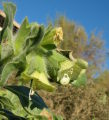 |
 |
IMAGE: HYOAL-01 Photo of the pale yellow flowers and buds of the White Henbane. |
IMAGE: HYOAL-02 Photo of a pair of flowers. There are 2 flower forms - this with a pale green throat and the other with a deep purple throat. |
IMAGE: HYOAL-03 Side view photo of the inflorescence having 2 blossomed flowers. Inflorescence is a spike (with sessile flowers) which unwinds at the flowering tip. |
IMAGE: HYOAL-04 Photo of flower and its hairy, funnel-shaped calyx. Also visible are anthers of 2 of its 5 stamens. |
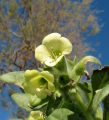 |
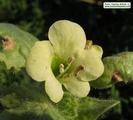 |
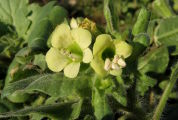 |
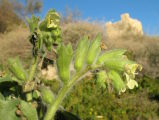 |
IMAGE: HYOAL-05 Photo of flowers having a 5 lobed corolla and stamens. In the lower flower, one of the stamens (the largest one) has not yet split open to release its pollen. |
IMAGE: HYOAL-06 Close up photo of flower. The lower 2 lobes of the corolla are smaller making the flower look somehow zygomorphic rather than actinomorphic. |
IMAGE: HYOAL-07 Photo of another flower pair. The younger still bears 3 unripe stamens (large with a smooth surface). |
IMAGE: HYOAL-08 Photo of inflorescence which is a unilateral spike, that is having sessile flowers at one side of the flowering branch. As seen, inflorescence unwinds at the flowering tip. |
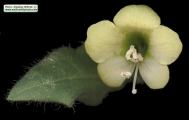 |
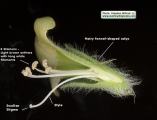 |
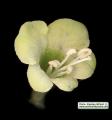 |
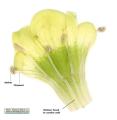 |
IMAGE: HYOAL-09 Scanned image of flower. Corolla segments fused with 5 free circular lobes. |
IMAGE: HYOAL-10 Scanned and annotated image of flower (lateral view). |
IMAGE: HYOAL-11 Magnified scanned image of flower showing the cream pollen covering the anthers and sitting on the corolla. Style swollen, white and longer by few millimetres than the stamens. Stamens of unequal length. |
IMAGE: HYOAL-12 Scanned image of a dissected corolla showing the 5 stamens fused to it. |
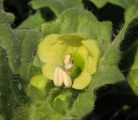 |
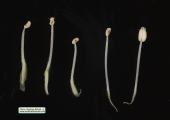 |
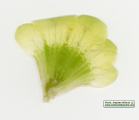 |
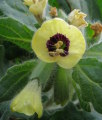 |
IMAGE: HYOAL-13 Photo of stamens in situ. The large unripe anthers measure 3mm in length. Anthers ripe at different time probably so that there is a continuous supply of pollen during the flower life. |
IMAGE: HYOAL-14 Scanned image of the stamens. The rightmost anther is unripe. |
IMAGE: HYOAL-15 Scanned image of a corrolla showing the pattern of the green throat and veins. Stamens dissected out. |
IMAGE: HYOAL-16 The plant exists in two flower forms, the green throated form and the purple-throated form. The latter seen in this photo. |
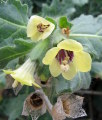 |
 |
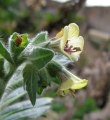 |
 |
IMAGE: HYOAL-17 Photo of flowers of the purple-throat form. Note that the stamens' filaments are also purple, where those in the green-throat flower form, are green. |
IMAGE: HYOAL-18 Close up photo of the flowers (purple-throated form). |
IMAGE: HYOAL-19 Sideview photo of the purple-form flowers. The structure is identical to the green-throat flowers. |
IMAGE: HYOAL-20 Photo of the flowering part of stem with two purple-throated flowers and the hairy leaves arranged alternately along stem. |
 |
 |
 |
 |
IMAGE: HYOAL-21 Rows of calyces along the flowering branch - about 20mm in length. |
IMAGE: HYOAL-22 Another photo showing the calyces that bear a fruit capsule inside at the base. |
IMAGE: HYOAL-23 Close up photo of calyx. Tubular to funnel-shaped with 5 actinomorphic teeth at its opening. |
IMAGE: HYOAL-24 Scanned image of calyx. Covered with soft white hair (referred to as villous hair). Also note the longitudinal veins, 10 in total. |
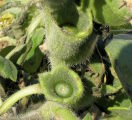 |
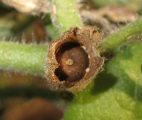 |
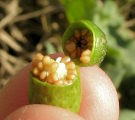 |
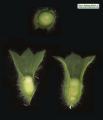 |
IMAGE: HYOAL-25 Photo of calyces showing their rounded fruit capsule inside. |
IMAGE: HYOAL-26 Photo of ripe fruit which turns brown on drying. The capsule cap splits open releasing the numerous tiny seeds inside. |
IMAGE: HYOAL-27 Photo of an unripe fruit with the upper cap forced opened to reveal the seeds inside. |
IMAGE: HYOAL-28 Scanned image of fruit. |
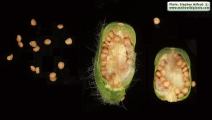 |
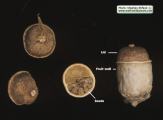 |
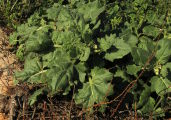 |
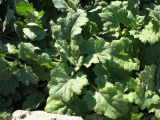 |
IMAGE: HYOAL-29 Scanned image of 2 longitudinally dissected fruit capsules (unripe) and their stored seeds. |
IMAGE: HYOAL-30 Scanned image of ripe fruit capsules and their covering caps which resemble a breast (as the Maltese name 'mammazejza' suggests.). |
IMAGE: HYOAL-31 Photo of the many leaves with pinnate venation (light green) that each plant produces. |
IMAGE: HYOAL-32 Photo of leaves. Stalked with a deeply serrated outline. |
 |
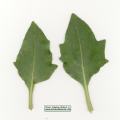 |
 |
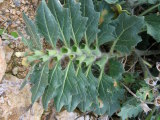 |
IMAGE: HYOAL-33 Close up photo of typical leaf. Not as hairy as the stem or calyces. |
IMAGE: HYOAL-34 Scanned image of 2 young leaves. Rather oval in shape with an undented base. |
IMAGE: HYOAL-35 Scanned image of an adult leaf having a triangular or rounded general outline with an indented base. Petiole long as leaf-blade length or more. Simple but prominent pinnate venation. |
IMAGE: HYOAL-36 Photo of rows of stalked leaves and sessile fruit calyces. |
 |
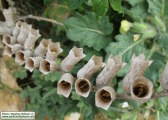 |
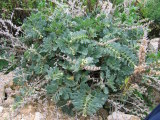 |
 |
IMAGE: HYOAL-37 Photo of unripe spherical fruit capsules resting at the base inside each calyx. |
IMAGE: HYOAL-38 Photo of ripe fruit consisting of dried calyces and fruit capsules inside. Some capsules still bear some seeds. |
IMAGE: HYOAL-39 Photo of a mature plant (or few plants near each other) having some old fruiting stems seen as dried, pale brown branches prominent calyces. This plant bears flowers with a purple throat. |
IMAGE: HYOAL-40 Photo of plant among stoney wasteground in a quarry at Gozo (Limits of Dwejra). |
 |
 |
 |
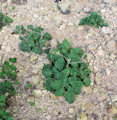 |
IMAGE: HYOAL-41 Photo of several plants found at the Public Garden of Wied iz-Zurrieq. |
IMAGE: HYOAL-42 Photo of herbaceous plant with many somehow fleshy leaves. |
IMAGE: HYOAL-43 Photo of plant showing its hairy stem, alternate leaves, axilliary fruit (calyces) and sessile flowers at the apex. |
IMAGE: HYOAL-44 Photo of young plants. |
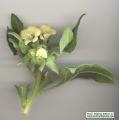 |
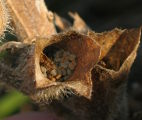 |
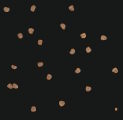 |
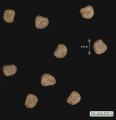 |
IMAGE: HYOAL-45 Scanned image of upper part of plant (inflorescence). |
IMAGE: HYOAL-46 Photo of a ripe dried fruit showing numerous seeds inside. These will simply fall off with swaying of the plant. No special dispersal mechanism. |
IMAGE: HYOAL-47 Scanned image of seeds. Somehow their shape looks like a swollen kidney but it varies. |
IMAGE: HYOAL-48 Magnified scanned image of seeds showing their panned texture. |
 |
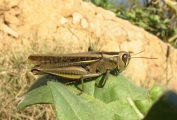 |
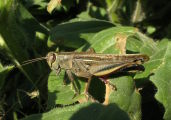 |
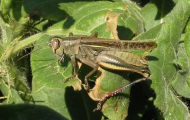 |
IMAGE: HYOAL-49 Colour illustration of several Hyoscyamus species. (Illus C. being H. albus). Taken from © 1995-2005 Missouri Botanical Garden.. |
IMAGE: HYOAL-50 Photo of the White Banded Grasshopper found feeding on this plant. Species name is Eyprepocnemis plorans. |
IMAGE: HYOAL-51 Photo of the White Banded Grasshopper found feeding on the White Henbane. |
IMAGE: HYOAL-52 Photo of the White Banded Grasshopper found feeding on the White Henbane. |
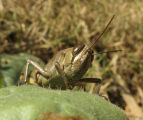 |
 |
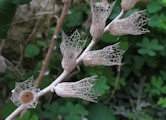 |
 |
IMAGE: HYOAL-53 Photo of the White Banded Grasshopper found feeding on the White Henbane. |
IMAGE: HYOAL-54 Artistic photo of old calices of the plant (1). |
IMAGE: HYOAL-55 Artistic photo of old calices of the plant (2). |
IMAGE: HYOAL-56 Artistic close-up photo of an old calyx. The remaining venation of the calyx looks like lace-art. |
|
| | |

